Abstract
The diagnosis of the small (4- to 6-microns) Cryptosporidium oocysts is labor intensive and relies on stool concentration, with subsequent staining and microscopy. The primary purpose of this study was to evaluate the clinical utility of an antigen capture enzyme-linked immunosorbent assay (ELISA) (LMD Laboratories, Carlsbad, Calif.) in detecting Cryptosporidium oocysts in human stools. A total of 591 specimens (76 diarrheal, 515 control) obtained from 213 inhabitants of an urban slum in northeastern Brazil were examined by both ELISA and conventional microscopic examination (CME) of formalin-ethyl acetate-concentrated stool samples stained with modified acid-fast and auramine stains. Forty-eight diarrheal stools (63.2%) were positive for Cryptosporidium oocysts by CME, with 40 of these positive by ELISA. Thirty-five control stools (6.8%) had Cryptosporidium oocysts detected by CME, with 15 of these also positive by ELISA. All of the 480 nondiarrheal stools and all but one of the diarrheal stools negative by CME were negative by ELISA. The test had an overall sensitivity of 66.3% and a specificity of 99.8% (positive predictive value, 98.2%; negative predictive value, 94.8%). In the evaluation of human diarrheal stool samples, the test sensitivity increased to 83.3%, with a specificity of 96.4%, and, in analysis of samples from individual patients with diarrhea, the sensitivity was 87.9%, with a specificity of 100%. These results indicate that this stool ELISA is sensitive and specific for the detection of Cryptosporidium oocysts in human diarrheal stool specimens but has limited use in epidemiologic studies for the diagnosis of asymptomatic Cryptosporidium infection.
Full text
PDF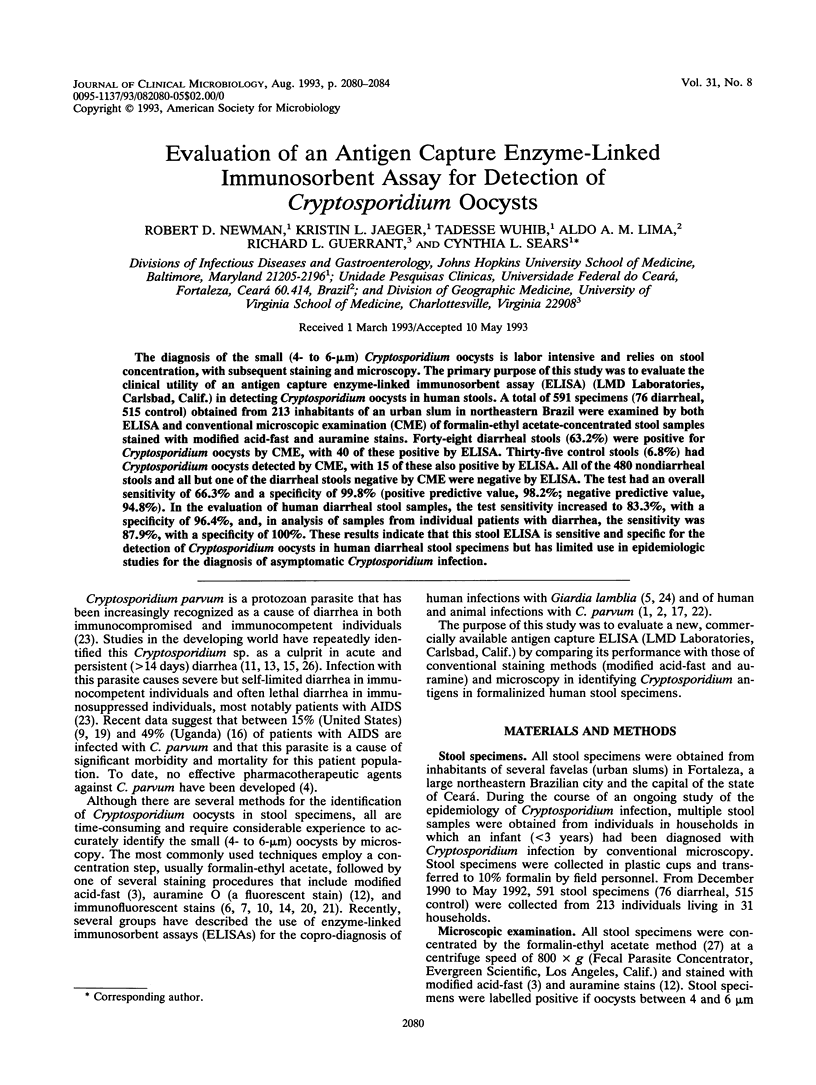
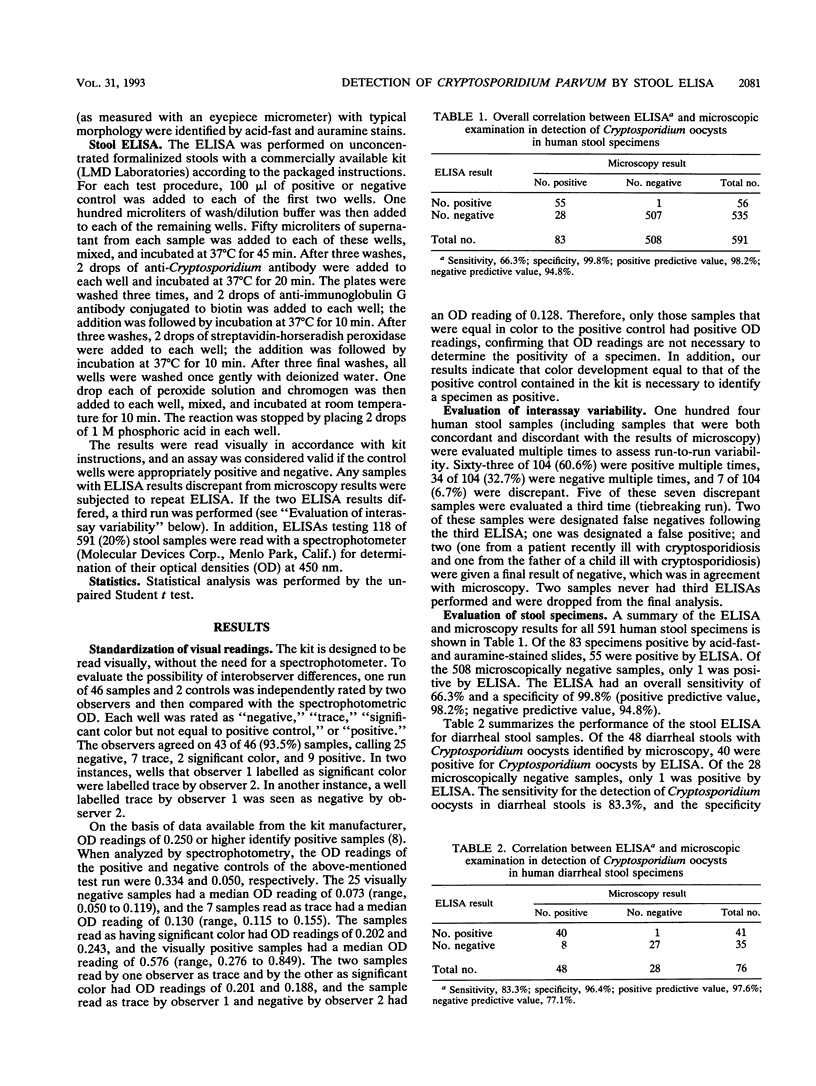
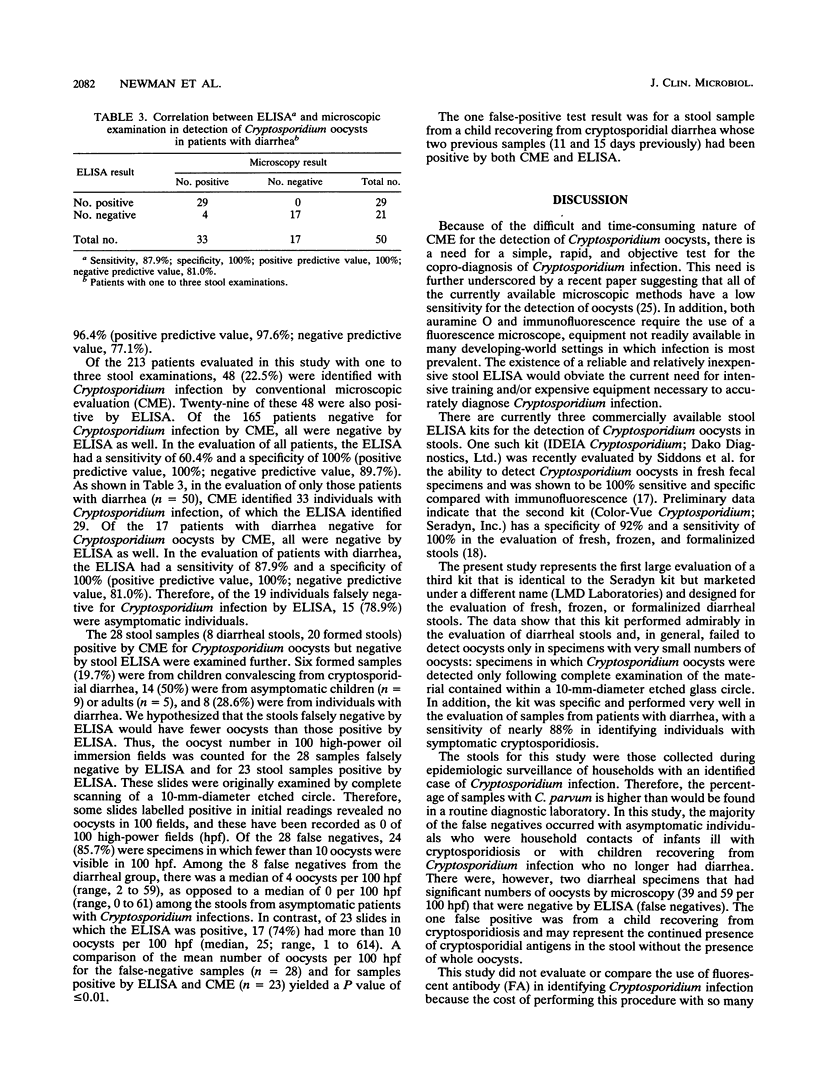
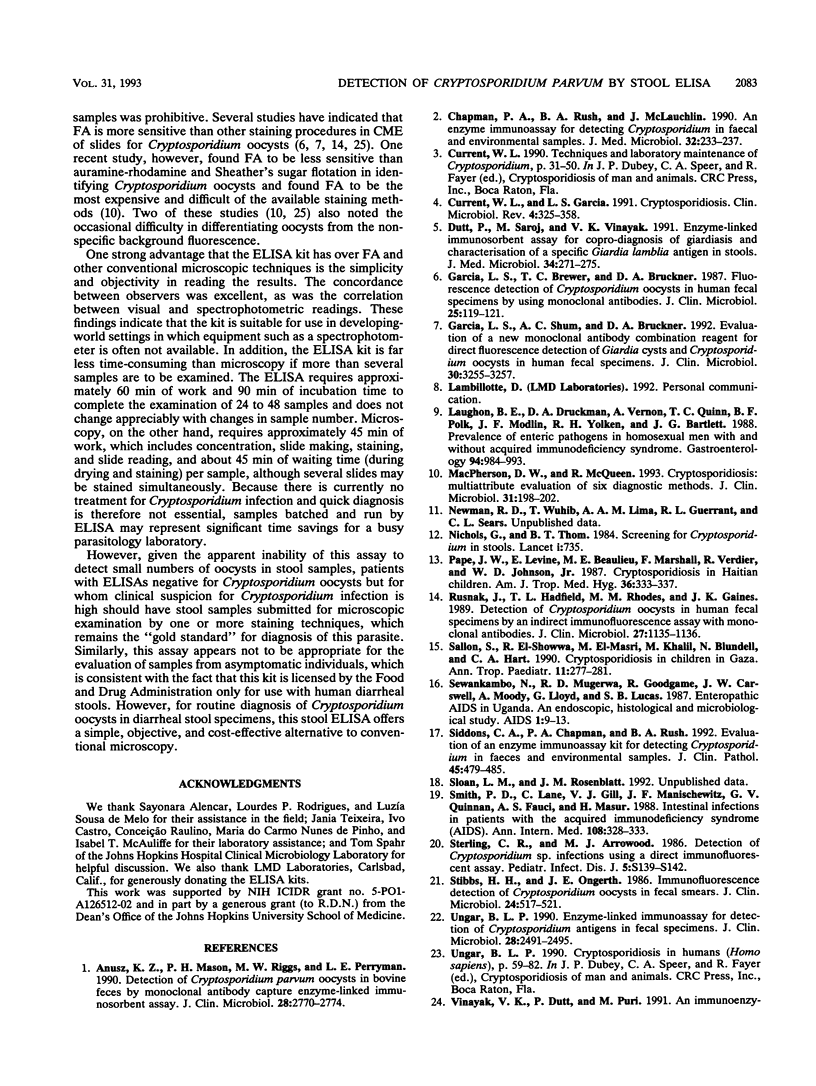
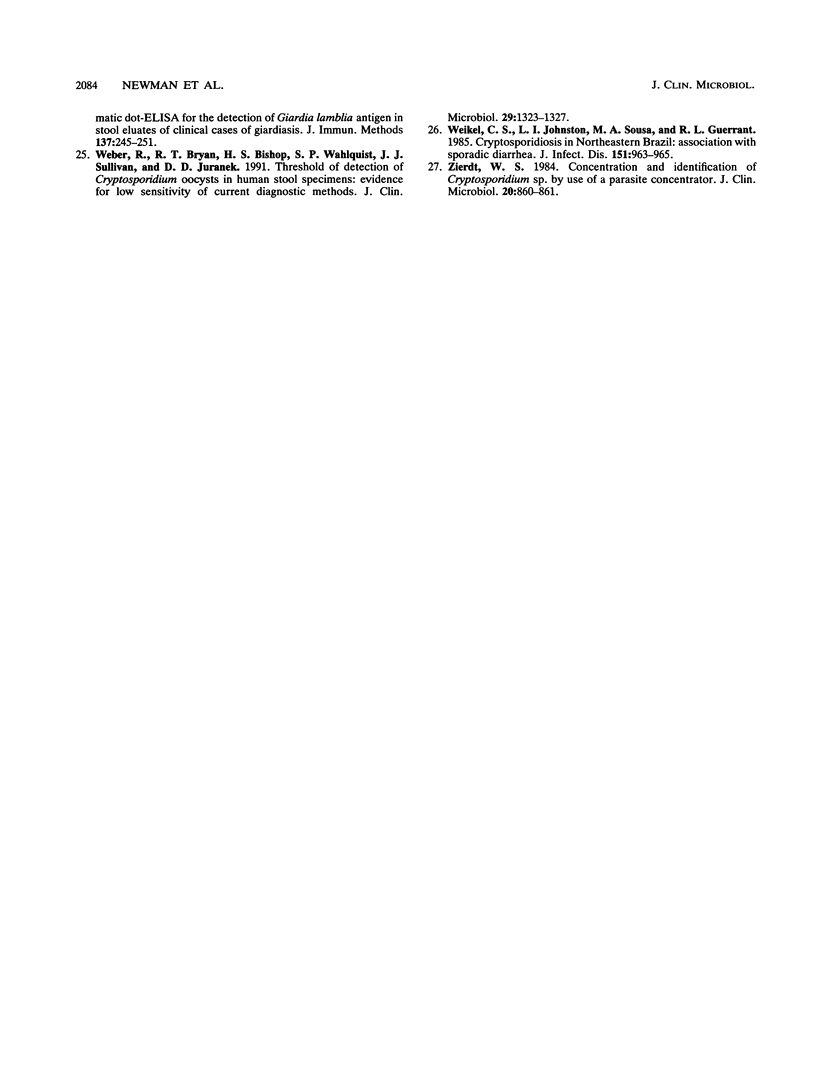
Selected References
These references are in PubMed. This may not be the complete list of references from this article.
- Anusz K. Z., Mason P. H., Riggs M. W., Perryman L. E. Detection of Cryptosporidium parvum oocysts in bovine feces by monoclonal antibody capture enzyme-linked immunosorbent assay. J Clin Microbiol. 1990 Dec;28(12):2770–2774. doi: 10.1128/jcm.28.12.2770-2774.1990. [DOI] [PMC free article] [PubMed] [Google Scholar]
- Chapman P. A., Rush B. A., McLauchlin J. An enzyme immunoassay for detecting Cryptosporidium in faecal and environmental samples. J Med Microbiol. 1990 Aug;32(4):233–237. doi: 10.1099/00222615-32-4-233. [DOI] [PubMed] [Google Scholar]
- Current W. L., Garcia L. S. Cryptosporidiosis. Clin Microbiol Rev. 1991 Jul;4(3):325–358. doi: 10.1128/cmr.4.3.325. [DOI] [PMC free article] [PubMed] [Google Scholar]
- Dutt P., Mehta S., Vinayak V. K. Enzyme-linked immunosorbent assay for copro-diagnosis of giardiasis and characterisation of a specific Giardia lamblia antigen in stools. J Med Microbiol. 1991 May;34(5):271–275. doi: 10.1099/00222615-34-5-271. [DOI] [PubMed] [Google Scholar]
- Garcia L. S., Brewer T. C., Bruckner D. A. Fluorescence detection of Cryptosporidium oocysts in human fecal specimens by using monoclonal antibodies. J Clin Microbiol. 1987 Jan;25(1):119–121. doi: 10.1128/jcm.25.1.119-121.1987. [DOI] [PMC free article] [PubMed] [Google Scholar]
- Garcia L. S., Shum A. C., Bruckner D. A. Evaluation of a new monoclonal antibody combination reagent for direct fluorescence detection of Giardia cysts and Cryptosporidium oocysts in human fecal specimens. J Clin Microbiol. 1992 Dec;30(12):3255–3257. doi: 10.1128/jcm.30.12.3255-3257.1992. [DOI] [PMC free article] [PubMed] [Google Scholar]
- Laughon B. E., Druckman D. A., Vernon A., Quinn T. C., Polk B. F., Modlin J. F., Yolken R. H., Bartlett J. G. Prevalence of enteric pathogens in homosexual men with and without acquired immunodeficiency syndrome. Gastroenterology. 1988 Apr;94(4):984–993. doi: 10.1016/0016-5085(88)90557-4. [DOI] [PubMed] [Google Scholar]
- Lo Cascio V., Adami S., Galvanini G., Cominacini L., Scuro L. A. The time course of a hypercalcaemic crisis in acute primary hyperparathyroidism. Lancet. 1984 Mar 31;1(8379):735–736. doi: 10.1016/s0140-6736(84)92246-3. [DOI] [PubMed] [Google Scholar]
- MacPherson D. W., McQueen R. Cryptosporidiosis: multiattribute evaluation of six diagnostic methods. J Clin Microbiol. 1993 Feb;31(2):198–202. doi: 10.1128/jcm.31.2.198-202.1993. [DOI] [PMC free article] [PubMed] [Google Scholar]
- Pape J. W., Levine E., Beaulieu M. E., Marshall F., Verdier R., Johnson W. D., Jr Cryptosporidiosis in Haitian children. Am J Trop Med Hyg. 1987 Mar;36(2):333–337. doi: 10.4269/ajtmh.1987.36.333. [DOI] [PubMed] [Google Scholar]
- Rusnak J., Hadfield T. L., Rhodes M. M., Gaines J. K. Detection of Cryptosporidium oocysts in human fecal specimens by an indirect immunofluorescence assay with monoclonal antibodies. J Clin Microbiol. 1989 May;27(5):1135–1136. doi: 10.1128/jcm.27.5.1135-1136.1989. [DOI] [PMC free article] [PubMed] [Google Scholar]
- Sallon S., el Showwa R., el Masri M., Khalil M., Blundell N., Hart C. A. Cryptosporidiosis in children in Gaza. Ann Trop Paediatr. 1991;11(3):277–281. doi: 10.1080/02724936.1991.11747514. [DOI] [PubMed] [Google Scholar]
- Sewankambo N., Mugerwa R. D., Goodgame R., Carswell J. W., Moody A., Lloyd G., Lucas S. B. Enteropathic AIDS in Uganda. An endoscopic, histological and microbiological study. AIDS. 1987 May;1(1):9–13. [PubMed] [Google Scholar]
- Siddons C. A., Chapman P. A., Rush B. A. Evaluation of an enzyme immunoassay kit for detecting cryptosporidium in faeces and environmental samples. J Clin Pathol. 1992 Jun;45(6):479–482. doi: 10.1136/jcp.45.6.479. [DOI] [PMC free article] [PubMed] [Google Scholar]
- Smith P. D., Lane H. C., Gill V. J., Manischewitz J. F., Quinnan G. V., Fauci A. S., Masur H. Intestinal infections in patients with the acquired immunodeficiency syndrome (AIDS). Etiology and response to therapy. Ann Intern Med. 1988 Mar;108(3):328–333. doi: 10.7326/0003-4819-108-3-328. [DOI] [PubMed] [Google Scholar]
- Sterling C. R., Arrowood M. J. Detection of Cryptosporidium sp. infections using a direct immunofluorescent assay. Pediatr Infect Dis. 1986 Jan-Feb;5(1 Suppl):S139–S142. doi: 10.1097/00006454-198601001-00022. [DOI] [PubMed] [Google Scholar]
- Stibbs H. H., Ongerth J. E. Immunofluorescence detection of Cryptosporidium oocysts in fecal smears. J Clin Microbiol. 1986 Oct;24(4):517–521. doi: 10.1128/jcm.24.4.517-521.1986. [DOI] [PMC free article] [PubMed] [Google Scholar]
- Ungar B. L. Enzyme-linked immunoassay for detection of Cryptosporidium antigens in fecal specimens. J Clin Microbiol. 1990 Nov;28(11):2491–2495. doi: 10.1128/jcm.28.11.2491-2495.1990. [DOI] [PMC free article] [PubMed] [Google Scholar]
- Weber R., Bryan R. T., Bishop H. S., Wahlquist S. P., Sullivan J. J., Juranek D. D. Threshold of detection of Cryptosporidium oocysts in human stool specimens: evidence for low sensitivity of current diagnostic methods. J Clin Microbiol. 1991 Jul;29(7):1323–1327. doi: 10.1128/jcm.29.7.1323-1327.1991. [DOI] [PMC free article] [PubMed] [Google Scholar]
- Weikel C. S., Johnston L. I., De Sousa M. A., Guerrant R. L. Cryptosporidiosis in northeastern Brazil: association with sporadic diarrhea. J Infect Dis. 1985 May;151(5):963–965. doi: 10.1093/infdis/151.5.963. [DOI] [PubMed] [Google Scholar]
- Zierdt W. S. Concentration and identification of Cryptosporidium sp. by use of a parasite concentrator. J Clin Microbiol. 1984 Nov;20(5):860–861. doi: 10.1128/jcm.20.5.860-861.1984. [DOI] [PMC free article] [PubMed] [Google Scholar]


